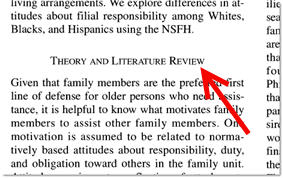
In the humanities and social sciences, primary sources are the direct evidence or first-hand accounts of events without secondary analysis or interpretation. A primary source is a work that was created or written contemporary with the period or subject being studied. Secondary sources analyze or interpret historical events or creative works. A tertiary source presents summaries or condensed versions of materials, usually with references back to the primary and/or secondary sources.
A literature review:
See also:
Once you've located some articles, you will need to begin reviewing the articles in your results list. Most empirical articles contain the information listed below, even though it may be found under different headings. Review each section to see what questions the article attempts to answer. Does the evidence presented support the claims that are made? How do these claims relate to the piece of conventional wisdom you're exploring?
Introduction
Here, the author will introduce the research questions explored in the study and why they are important.
Literature Review
The literature review surveys the scholarly work that has already been conducted on the topic. This section provides support for the research questions the author is asking.
Methodology
This is where the author outlines the nuts and bolts of the study. The methodology section describe how the study was conducted, what methods were used and how the data was analyzed.
Results
Here, the author shares the data that was collected and analysis of that data.
Discussion
The discussion section is where the author highlights the importance of the study's results, how those results relate to the research questions and what the results mean.
Conclusion
Finally, the author summarizes the results of the study and makes suggestions for additional research.
The Literature Review portion of a scholarly article is usually close to the beginning. It often follows the introduction, or may be combined with the introduction. The writer may discuss his or her research question first, or may choose to explain it while surveying previous literature.

If you are lucky, there will be a section heading that includes "literature review". If not, look for the section of the article with the most citations or footnotes.